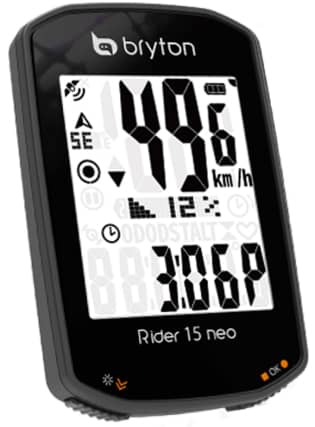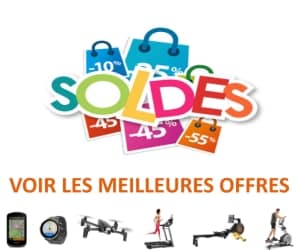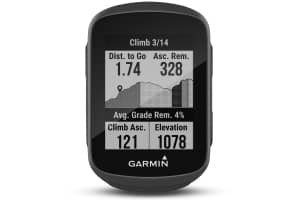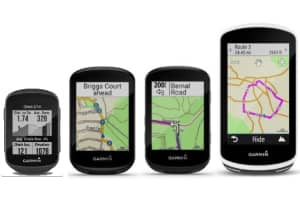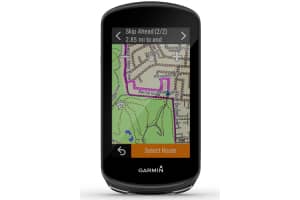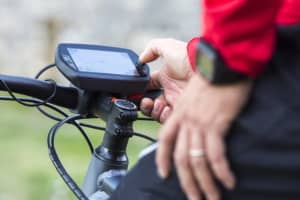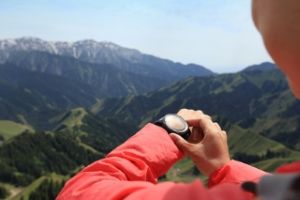Buy Bryton Rider 15 NEO
Quick introduction to the Bryton Rider 15 NEO
A meter offering the essentials at a low price and requiring no sensor to operate
The Bryton Rider 15 NEO is Bryton's entry-level bicycle and mountain bike GPS computer. Despite its price of less than 80 €, it offers the essential functions for bike and mountain bike rides and will satisfy most cyclists who are not looking for superfluous functions or training tools. It's hard to find better at this price!
It is a compact, lightweight meter that requires virtually no mounting (it can operate without a speed sensor thanks to GPS). It features a comfortable 2" (5 cm) diagonal monochrome non-touch display with up to 5 customizable data screens and a maximum of 4 data per page.
As far as sensors are concerned, it is well equipped. It has a high-sensitivity GPS compatible with the main satellite systems (GPS, Galileo and QZSS), a barometric altimeter, a thermometer and a digital compass indicating North. It is compatible with some external Bluetooth sensors: cardio belt, speed sensor and cadence sensor. For power readings, you'll need to invest in a higher-end model.
The Rider 15 NEO offers up to 21 functions, including an auto-pause function, displays essential route data (time, distance and GPS speed, percentage of gradient, difference in height, speed compared to average), has an odometer and records your route to be displayed on a map after the ride (PC or Smartphone). It can also be fitted with a speed sensor for more accurate distance and speed measurements, a cadence sensor or a cardio belt for heart rate and threshold heart rate readings and evaluation of the calories expended.
The Rider 15 NEO offers Smartphone notifications (emails, calls and messages).
On the connectivity side, data synchronisation is done via Bluetooth to your iOS or Android smartphone. The Bryton application also allows automatic synchronisation to Strava, TrainingPeaks, Selfloops and Relive and is compatible with other popular applications such as Endomondo, Map My Ride or Fit Track.
The autonomy of this GPS is 16 hours with possible recharging during the outing via an external battery.
Who is the Rider 15 NEO for?
The Rider 15 NEO is designed for cyclists and mountain bikers who are looking for an easy-to-use computer with no superfluous features that are essential for riding. It is also ideal for beginners or people on a limited budget who are looking for a good GPS computer. Its value for money is indeed excellent.
Characteristics of the Bryton Rider 15 NEO
71,1 x 46,1 x 21,6 mm, 51 g
Screen
Monochrome, non-touch, 2" (5 cm)
Sports
Bike, mountain bike
Autonomy
Up to 16 h
Memory
History 30 h (120 h in smart mode)
GPS
GPS, Galileo, QZSS. High sensitivity receiver
Cartography
-
Barometric altimeter
Yes
Bluetooth: cardio belt, cadence, speed
Thermometer
Yes
Burnt calories
Yes (with cardio belt)
Weather
-
Waterproof
IPX7 (withstands rain, snow, mud, splashes)
Other
Ultra-compact and lightweight, 21 functions, Bluetooth connection, synchronisation with Strava, TrainingPeaks, Relive and Selfloops, auto-pause function, backlighting
Detailed review of the Bryton Rider 15 NEO
Use
The Bryton Rider 15 NEO has the advantage of being simple and efficient. It has only 3 buttons and offers a comfortable and well-organised screen. The operating instructions are in English but French-speaking people can download the instructions in French for the Rider 15 NEO from the Bryton website. It displays clear steps for getting started (installation and pairing to a Smartphone).
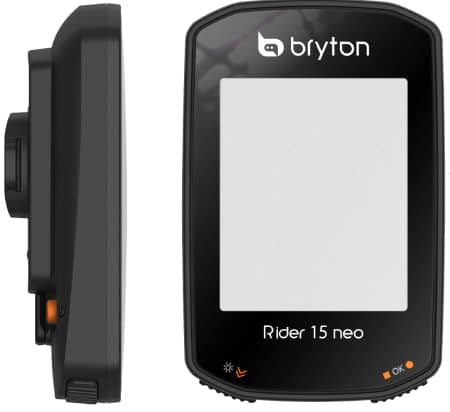
The computer is delivered with a bike mount to be installed on the stem. It is also possible to buy an additional support to screw on the handlebars. There is no need to install a speed sensor and set the wheel size: the onboard GPS takes the speed and distance readings. This is very useful if you're not a handyman or if you are in a hurry! On the other hand, the accuracy of the measurements can be a bit disappointing if you drive in places where the GPS signal is weak (forests, buildings, under power lines, etc.). It is therefore better to acquire a speed sensor to be placed on the wheel, especially for use on a mountain bike.
Getting started couldn't be simpler: you charge the device for 4 hours, you switch it on, you choose once for all the measurement units (distance in kilometres or miles, temperature in degrees Celsius or Fahrenheit), you wait for the detection of the satellites (30 to 60 seconds during the first launch, it will be faster afterwards) and you can go!
The counter can be set directly from the 3 buttons available on the device. However, it is preferable to pair it with a smartphone (Android or iOS) for easier programming and, of course, to be able to use, share or synchronise the data recorded from bike rides to other applications. Bryton offers an application for this (Bryton Active), to be installed on the phone. Another application, Bryton Update Tool, allows the automatic update of the firmware and GPS data (satellite position).
The configuration allows you to define a bike profile (2 in total can be programmed, either for 2 users or for 2 bikes) by indicating the wheel size. It is necessary to calibrate the altitude (automatic or manual), to pair any external sensors (cardio belt, cadence sensor, speed sensor, combined cadence and speed sensor), to choose the time format, to choose the satellite systems (GPS alone or in association with another system), to adjust the odometer (setting of the total mileage)
Other more advanced settings allow you to manually calibrate the altitude, set up intelligent notifications (messages, emails, calls) and customise the display. Data fields can be selected. The Rider 15 NEO can display up to 4 per screen on up to 5 pages.
Once underway, the unit displays the direction with an arrow pointing, depending on the setting chosen, to the North or to the current direction. The speed display is also supplemented by arrows indicating whether you are driving below or above average speed, a rather playful and motivating tool if you want to challenge yourself.
Once the output is complete, the data can be synchronised to a smartphone or tablet via Bluetooth or copied to a computer via a USB cable.
Design and physical characteristics: compact, lightweight and a comfortable screen
The Rider 15 NEO offers a compact (71 x 46 and 21.6 mm thick), simple (3 buttons) design and an easy-to-read 2" monochrome display that is well contrasted and backlit during night-time outings (sunrise and sunset times are taken into account by the device).
Its watertightness (IPX7 standard) allows it to be used in the rain. It can withstand an immersion of 1 metre for 30 minutes. So there is no need to worry if it falls into a puddle for example. It also withstands temperatures ranging from -10°C to +60°C, which leaves some room for manoeuvre.
Autonomy: 16 hours max. and recharging possible during the outing.
The Rider 15 NEO has a battery life of 16 hours with one recording every second. That's pretty good for a meter at this price. Recharging takes only 4 hours. It can also be fitted with an external battery for ultra-long runs.
Up to 30 hours of activity can be recorded at a rate of one recording per second. For greater autonomy, Bryton has provided an intelligent mode where recordings are more spaced out but optimised (the recording frequency is adapted according to the type of data, the cyclist's speed, etc.). It is possible to reach 120 hours of recording time.
| Features | |
|---|---|
| Autonomy | 16 h |
| Battery Save Mode | No |
| Rechargeable while out | Yes |
| History | 30 h |
| History in smart mode | 120 h |
Sensors
The meter is very well equipped with sensors. Indeed, we find the equipment of top-of-the-range meters: high-sensitivity GPS chip, barometric altimeter, compass, thermometer.
As far as GPS is concerned, curiously, the Rider 15 NEO is only compatible with the American (GPS), European (Galileo) and Japanese (QZSS) GNSS(*) systems, whereas the previous model, the Rider 15, was compatible with all the satellite systems available to date: GPS, Galileo, Beidu (BDS) and QZSS.
Compatibility with other satellite systems allows for greater data reliability and faster lock-in, as more satellites are available and the quality of reception varies from system to system depending on the reception location. Bryton allows you to choose between GPS alone (the American system) and GPS combined with one of the two others (Galileo or QZSS). Note that the combination of several satellites reduces the battery life. We advise you to test the different options to get an idea and choose the best combination.
The other advantage of the Rider 15 NEO is that it offers a barometric altimeter, which is much more accurate and reliable than GPS for altitude measurements and evaluation of height difference. Importantly, it can also be calibrated manually for precise adjustment. Alternatively, it can be automatically adjusted from GPS data (less accurate).
The Rider 15 NEO is compatible with external Bluetooth sensors: cardio belt, cadence and speed sensors (including a combined sensor). The speedometer detects them automatically and displays an alert when it identifies a low battery level.
(*) GNSS : Global Navigation Satellite System
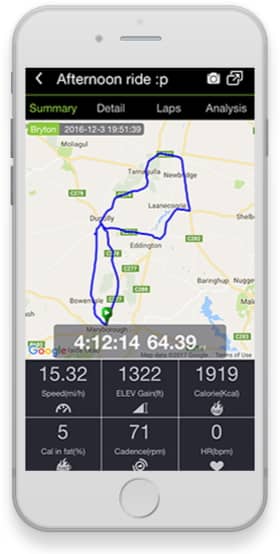
Functions
The Rider 15 NEO offers up to 21 functions (some of which are only available if external sensors are used): time, ride time and total time since use, speed (current, average and maximum), altitude (current and maximum), elevation gain and loss, gradient percentage, heart rate (current, average and maximum), cadence (current, average and maximum), temperature, direction (heading).
The computer also records the route (FIT format files), offers an auto-pause function (so that pause times are not counted), backlighting that can be activated manually, battery status display, low battery alerts for external sensors, and a synchronisation function to a smartphone or PC.
Smartphone notifications (calls, emails, messages) are also available, provided of course that you pair your Smartphone with the meter and take it with you on your outing. The telephone network must also be accessible.
The meter is compatible with popular applications (Endomondo, Fit Track, Map My Ride, etc.) and offers automatic synchronisation to Strava, TrainingPeaks, Selfloops and Relive. You can therefore analyse your output or share your data with the community.
Bryton Rider 15 versus Rider 15 NEO: comparison, differences
The Bryton Rider 15 NEO, released in 2021, is a revised version of the 2 year old Rider 15. Bryton has made some improvements to this model to make it more user-friendly and easier to use, thus erasing some of the negative comments from users.
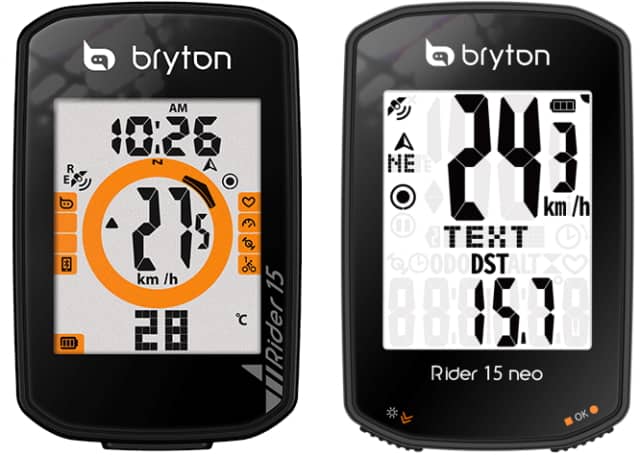
The differences does not seem to be huge, but they are worth the few extra euros you have to pay for this new model (the price of the new model remains the same as the old one, but the old one is cheaper). Indeed, the Rider 15 NEO benefits from better hardware, a better quality screen (better readability), an improved design (more practical buttons) and a complete revision of the display (more readable and better organised). These few changes clearly improve the device and make it more attractive than the Rider 15.
On the other hand, while Bryton provides "All GNSS" compatibility on all its latest models, including the Rider 15, this one is only compatible with 3 GNSS only. Moreover, it offers only 21 functions against 30 for the other model. But Bryton has only harmonised its descriptions: the 21 functions only include data that can be displayed on the screen, whereas the 30 functions of the Rider 15 include functions such as the auto-pause function, low battery alerts, etc. So there is no regression here.
The differences between the Rider 15 and the Rider 15 NEO can be summarised as follows:
- Improved hardware and software
- A better quality screen:reading is improved, the display remains readable even in bright sunlight and at any viewing angle
- A reorganisation of the display for better readability. The circle and small orange coloured slots printed on the Rider 15's display disappear in favour of an easier to read display. One can also benefit from the automatic scrolling of the data.
- A redesigned device with a better look and buttons easier to access
- The device gets a little thicker mm vs 16.5 mm and loses 1 gram.
- The backlight can be activated at any time. On the Rider 15, it was only activated at night, depending on the sunrise and sunset times of the place of use).
- The meter allows you to record laps.
- The loss of "All GNSS" compatibility: the Rider 15 NEO is only compatible with GPS, Galileo and QZSS systems
- The price unchanged but that of the Rider 15 decreases
Our opinion on the Bryton Rider 15 NEO
The Bryton Rider 15 NEO is a rather comprehensive wireless GPS bike computer for its price. The previous model, Rider 15, was appreciated by many of its users. This new model should bring even more satisfaction. As we wrote above, it is difficult to find a device as complete and of equivalent quality at this price level (less than 80 €)! It has everything to seduce small budgets or people who do not need advanced functions. The competitor Garmin offers more advanced counters but for around 150 € minimum. That said, the Rider 15 NEO has a few weaknesses, justified by the price, but to be taken into account depending on the intended use (read below).
What we like about this meter is its quality, compact design, comfortable to read screen (size and display), the number of sensors and functions available, sufficient for most cyclists. The course recording and statistics available on the interface as well as the synchronisation with other applications are also appreciable.
The barometric altimeter, which is much more accurate than GPS for altitude measurements and especially height difference calculations, is one of the big advantages of this low-cost model. The manual adjustment is also appreciated for better accuracy.
The screen is comfortable, well contrasted and the backlighting is appreciated for night outings or when the weather is gloomy. However, be aware that the autonomy may be significantly reduced (the 16 theoretical hours are calculated on the basis of use without backlighting). The Rider 15 NEO should be tested in real-life situations to get a more precise idea.
While this meter has the merit of being simple to use (no sensors to install), its reliability in terms of distance measurement leaves something to be desired if you are driving in places where GPS is not working properly. It can be the case for mountain biking with outings in the forest or in the city when riding in the middle of buildings. The meter relies exclusively on the GPS to evaluate the distance travelled, which can lead to some crazy measurements (straight lines between two GPS hooks). This problem can be solved by installing a Bluetooth speed sensor (wireless) for a much more accurate count. But this requires an additional cost of around thirty euros, thus reducing the interest of this economical meter!
It should also be noted, for mountain bikers, that the meter holder offers a fixing that would require a little firmer. In the event of a violent impact, the speedometer can come loose and fall.
All in all, this meter with its quality and low price for the functions offered seems perfect for sportsmen and women who are looking for a cheap but quality and relatively comprehensive GPS, with no superfluous functions, no GPS navigation and no training functions. As long as they are not too concerned about the accuracy of the track and the distance for outings where the GPS does not work well.
For more elaborate functions, such as GPS navigation or sports training, it will be necessary to invest in a slightly more expensive model. See our comparison of the best GPS-computers for cycling and mountain biking 2026.
- A comprehensive meter, easy to use and at a low price
- The compact and lightweight format
- The high-sensitivity GPS receiver
- The barometric altimeter and its manual calibration
- Improved hardware and a better screen (compared to the Rider 15)
- A comfortable and easy to read screen
- 2 bike profiles
- The auto-pause function
- 16 hours of autonomy and recharging possible during the activity
- The automatic synchronisation to Strava, TrainingPeaks, Selfloops and Relive and compatibility with other popular platforms
- The fact the distance measured depends on the quality of the GPS signal
- The instructions in English make it difficult to get started (but can be downloaded in French)
Price and availability
The Rider 15 NEO is available in 2 versions, with or without cadence sensor. The version with cadence sensor (Rider 15C NEO) is available around 90 €. The version without cadence sensor (Rider 15E NEO) is available around 70 €. Discover this counter at our partners and enjoy all year round discount vouchers.
Buy Bryton Rider 15 NEO
These articles may also interest you
Garmin Edge 130 Plus: a GPS bike and mountain bike computer with excellent value for money
Comparison Garmin Edge 130 Plus vs. 530 vs. 830 vs. 1030 Plus: differences, which one to choose?
Garmin Edge 1030 Plus: the ultimate GPS bike and mountain bike computer
Les meilleurs compteurs-GPS de vélo et VTT en 2026
Meilleures montres GPS altimètre 2026 pour la randonnée
Photo credit : Adobe Stock. This article contains commercial links.

